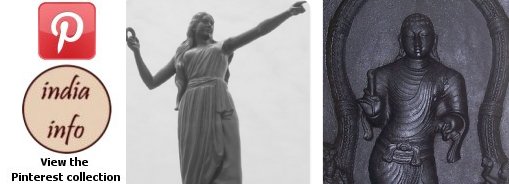Snippets of Information
Dance - Literature
* 5 Jul 2023
The Abhinaya Darpana, a comprehensive text describing various gestures,
postures and movements in Dance is ascribed to Nandikeshvara. It is very
likely that there were many persons during the ancient periods that
went by the name of Nandikeshvara.
The Abhinaya-Darpana deals, predominantly, with the Angikabhinaya (body
movements) or Gesture-language of the Nrtta class; and, is a text that
is used extensively by the Bharatanatya dancers. It describes
Angikabhinaya, composed by the combination of the movements of the Angas
(major limbs- the head, neck, torso and the waist); the Upangas (minor
limbs-the eyes, the eyebrows, the nose, the lower lip, the cheeks and
the chin); the Pratayangas (neck, stomach, thighs, knees back and
shoulders, etc) ; and, the expressions on the countenance.
Source: The texts of the Indian Dance traditions - Part Eleven, Lakshana Granthas - Abhinaya Darpana, sreenivasaraos.com
* 5 Jul 2023
Bhramari - Taking a turn while dancing. According to Natyashastra, there are seven types of Bhramari. These are:
Utpluta Bhramari: Keeping the feet together in Samapada, make a complete circle. (Turn round completely). This is Utpluta.
Chakra Bhramari: Standing on the toes, holding both hands in tripataka, take a complete circle, using quick steps. This is called chakra.
Garuda Bhramari: Sitting on one knee, stretching the other leg,
move around having the bent knee as fulcrum, with both hands
outstretched. This is called Garuda.
Eka pada Bhramari: While standing on one leg, the other leg is
lifted and a quick round is made on that planted foot, and vice versa.
This is called ekapada.
Kunchita Bhramari: Rotating on the toes with bent knees is called kunchita.
Aakaash Bhramari: Leap with legs stretched and turning around, land in samapada. This is called samapada.
Anga Bhramari: Starting with the feet placed one cubit apart,
leap in the air and after a circling movement land in the original
position. This is called anga.
Source: kalyanikalamandir.com/blogs/bhramari-lakshanam/
* 7 May 2023

Silappadikaram, Prof. Nagaswamy maintained, is a dance drama
from beginning to end and adopts the tradition of Sanskrit dramas, such
as praying/blessing the king at the beginning and at the conclusion of
the drama. The Aranga Kaadai in the first volume of Silappadikaram gives
details to be followed in a dance drama such as the five different
geographical types of lands, the people there, their life styles,
emotions as also the characters in the drama, the costumes, jewellery
and stage décor. These are exactly the same as found in the Natyasastra
of Bharathamuni. Silappadikaram covered the areas from Kumarikandam to
Thiruvengadam which comprise all the five types of lands and these had
to be enacted on stage by gestures so that the audience could build a
mental picture. Many words, such as ‘pindi,’ which originally signified
the essential qualities for a dance/dancer, have been later on
interpreted as hand gestures.
There have been Tamil texts on dance earlier to Bharatha’s Natyasastra
but these have been lost. In Silappadikaram Ilango mentions that Madhavi
was awarded by the Chola king because she adhered strictly to the Natya
Nannool, which was obviously Natyasastra. The text Koothunool is
probably a later one since it talks of dance forms which came into being
much later. Prof. Nagaswamy, a multifaceted scholar and a
multilinguist, cited several such examples in Silappadikaram , which
have been inspired from Natyasastra.
Source: Tracing an epic’s roots by Lakshmi Venkatraman, The Hindu, June 20, 2013
* 11 Nov 2022
24 hand gestures or the Hastas has been codified in the Hasta Lakshana Deepika
Mudras
or Hastas plays the most important role in Angika Abhinaya. It has the
place of alphabets in a language. Hastas convey the meaning of a song,
helps in expressing an emotion better through gestures according to the
situation and hence making it a visual treat for the Rasikas or the
audience.
Each of the fingers has a name.
1. Little finger - Kanishta
2. Ring Finger - Anamika
3. Middle Finger - Madhyama
4. Index Finger - Tharjani
5. Thumb - Angushtam
These fingers are used to portray the 24 hand gestures or the Hastas
which has been codified in the Hasta Lakshana Deepika which literally
means the Lamp showing the Purpose of Hand Gestures (of which the author
is unknown). It should been noted that the Asamyutha Hastas (Single
Hand Gestures) classified in the Natyashastra is slightly different from
those in Hasta Lakshana Deepika. Mohiniyattam follows the Abhinaya
concepts written in Hasta Lakshana Deepika and Abhinaya Darpana (Mirror
of Gesture) authored by Nandikeswara.
Pathaka, Mudrakya, Katakam, Mushti, Kartharimukha, Shukathunda,
Kapithakam, Hamsapaksham, Shikaram, Hamsasyam, Anjali, Ardhachandram,
Mukuram, Bhramaram, Soochikamukham, Pallavam, Tripathakam,
Mrigasheersham, Sarpashiras, Vardhamanakam, Araalam, Oornanabham,
Mukhulam, Katakamukham are the 24 hand gestures.
Source: mohiniyattamdance.blogspot.com
Hastha Lakshana Deepika is a text exploring the hand gestures used in
dancing. Koodiyaatam, Kathakali and Kerala Natanam follow this as the
manual of gestures or 'mudras', which is believed to have been written
in Kerala. Hastha Lakshana Deepika recognizes 24 basic hand gestures
called 'chatur vimsathi mudras' and nearly 300 combined gestures.
Source: SEVENTY YEARS OF KERALA NATANAM by G Vinodini, Trivandrum, narthaki.com
|